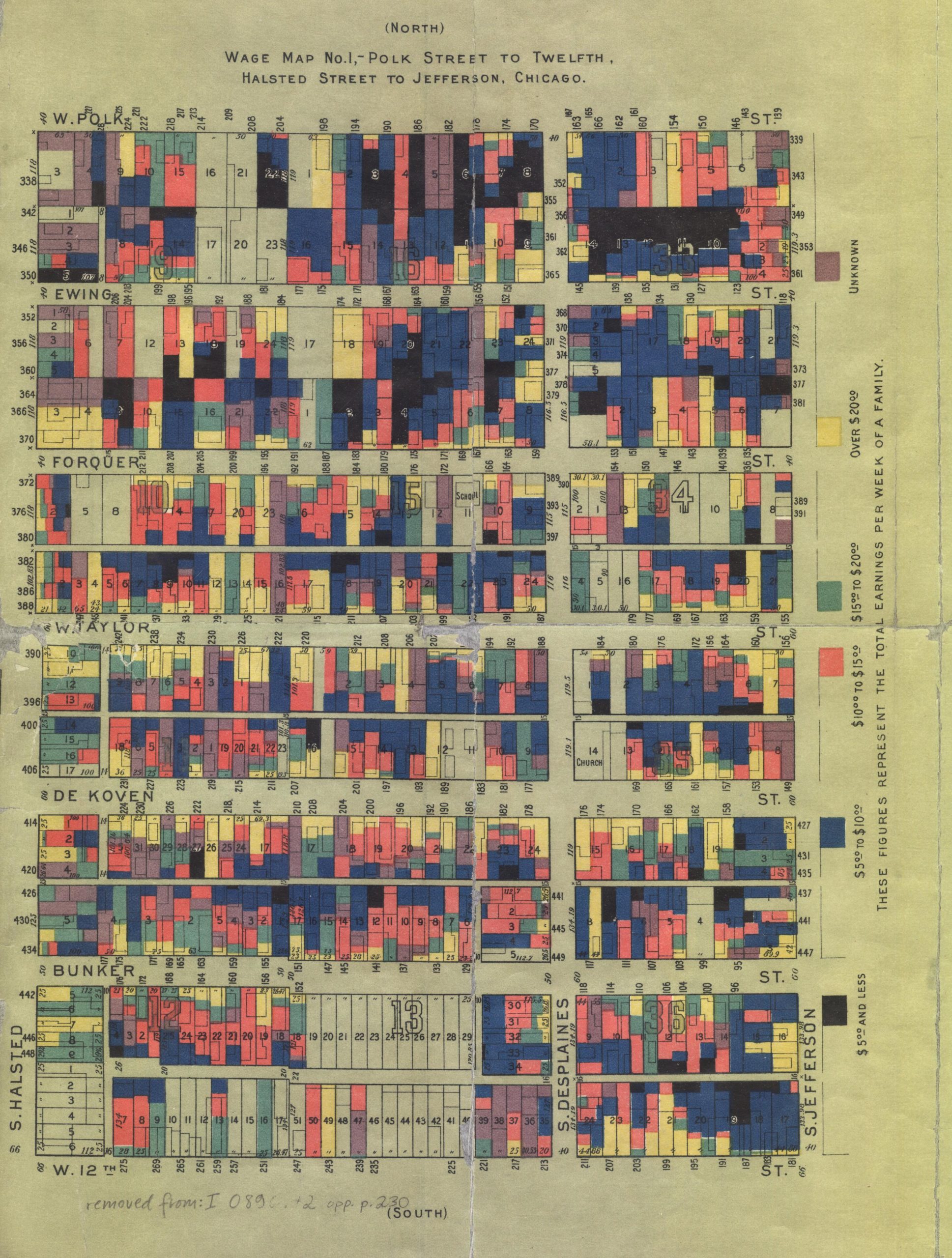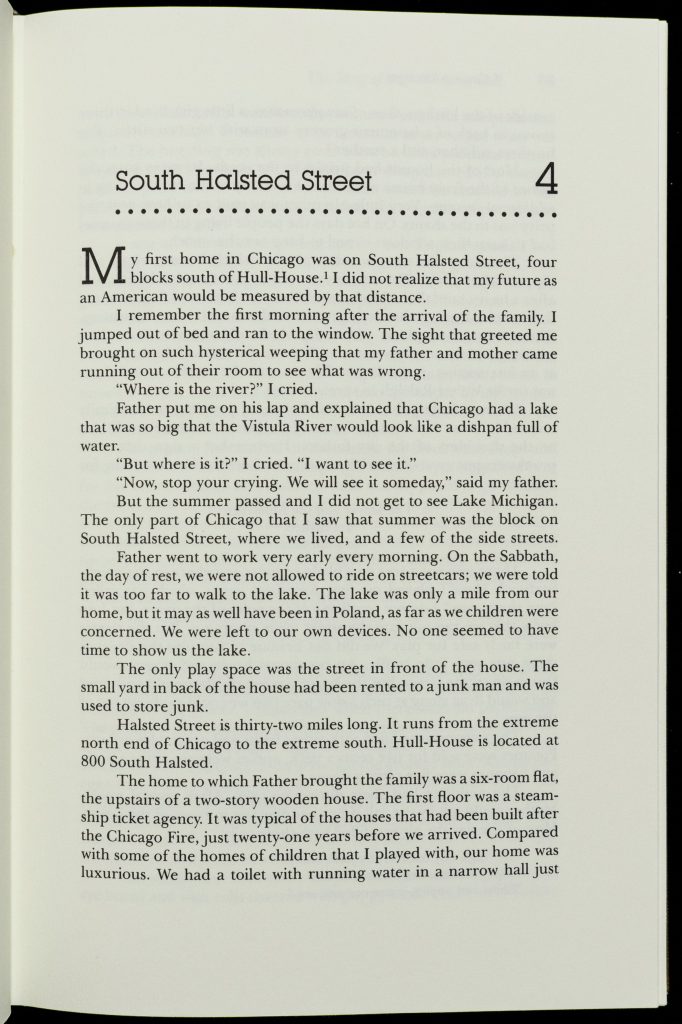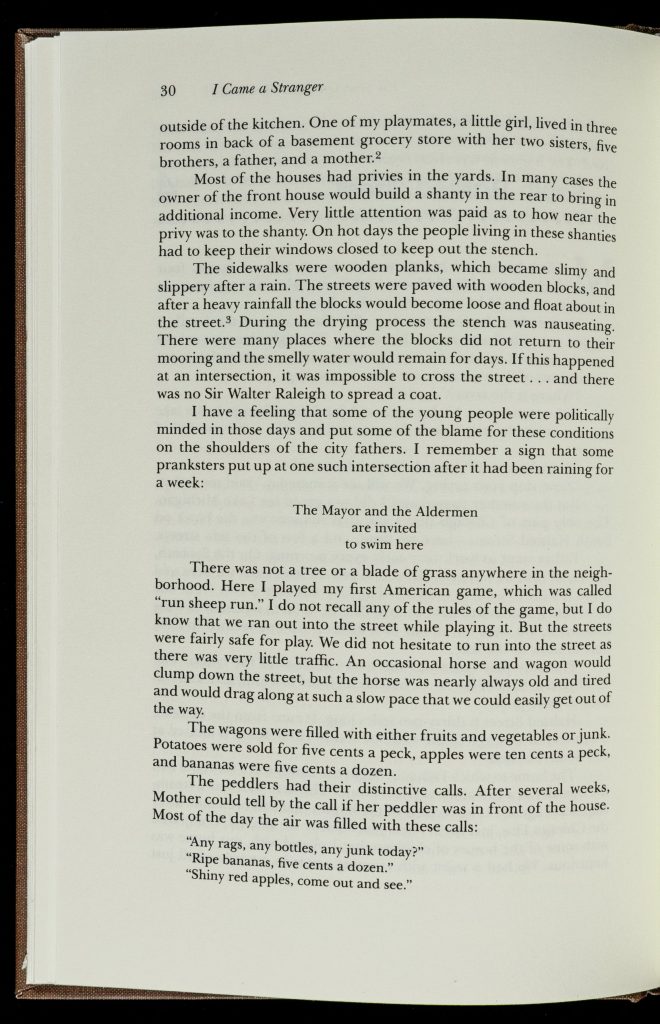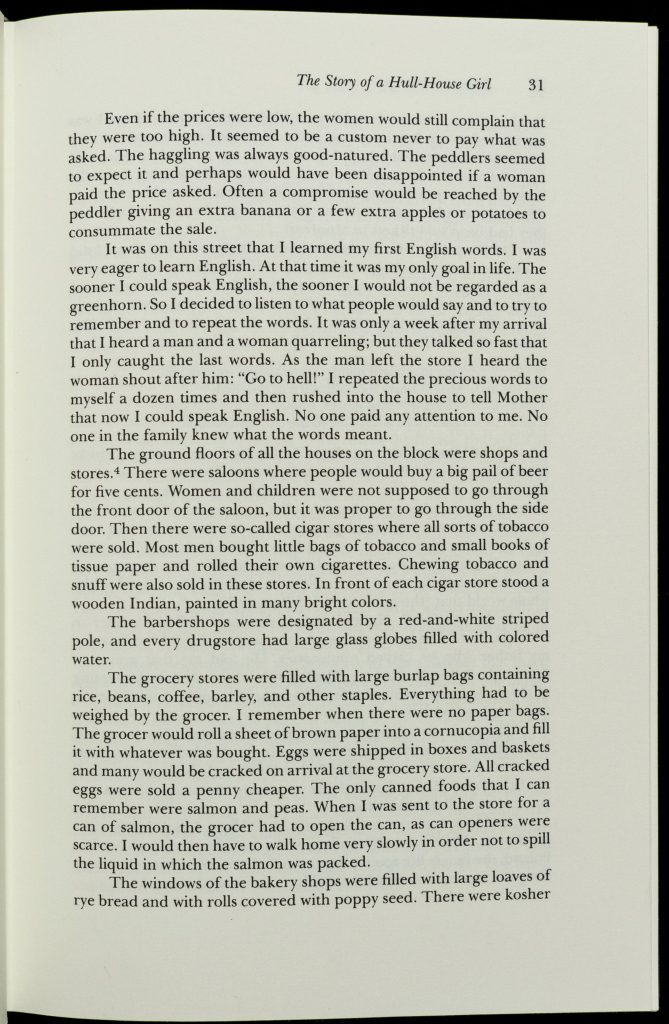Curriculum Connections: Chicago History, Immigration, Progressive Era, Settlement House Movement
From Hull House Maps and Papers, New York: T.Y. Crowell & Co., c. 1895
Sources in this lesson also appear in the Collection Essays Faith in the City: Religion and Urban Life in Chicago, 1870-1920, Chicago Workers during the Long Gilded Age, and Immigration and Citizenship in the United States, 1865-1924.
Download a copy of this lesson plan or a copy of the sources in the Downloads tab.
Process
You and your students will examine two maps created by the staff of Chicago’s Hull House in 1895. You will encourage students to get as much information as they can from each map and both maps together, using a two-step process. First, identify questions the maps might answer. Second, try to answer the questions.
After you have looked at both maps, you will read a short excerpt from an autobiography called I Came a Stranger: The Story of a Hull House Girl, by Hilda Satt Polacheck, which describes life in the neighborhood shown on the maps.
Use the background material at the end of the second and third sources whenever you think it will encourage students to ask more questions and engage more effectively.
First source – Wage Map
Click on the image for a high-resolution version that can be displayed for your class.
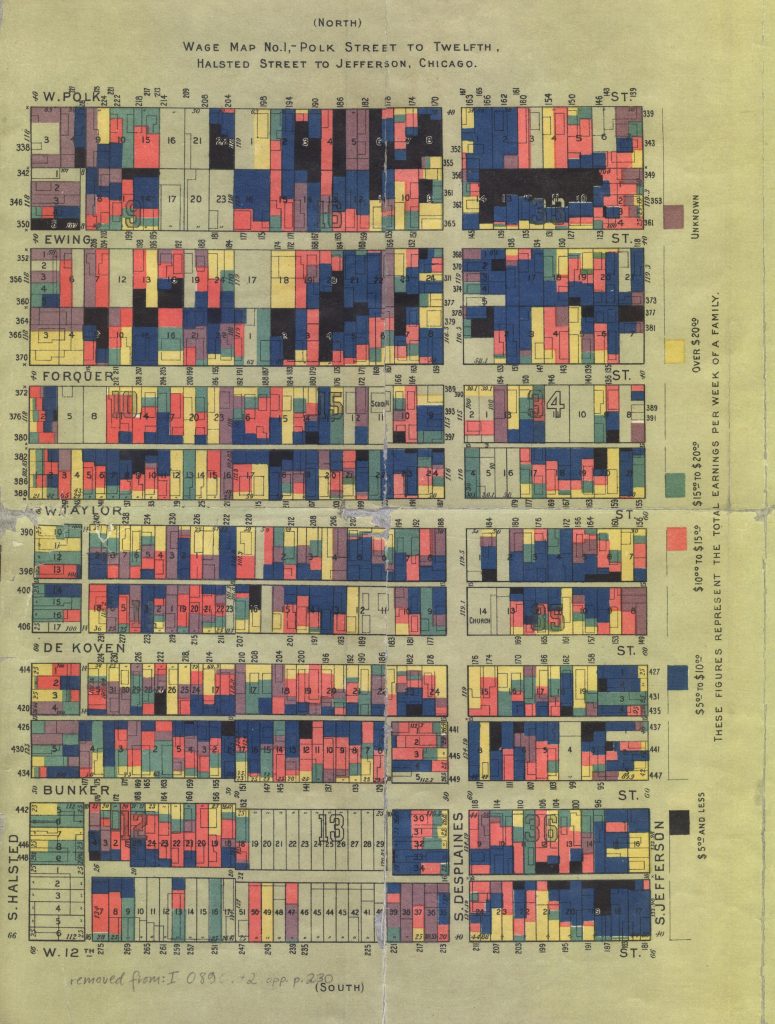

While looking at this map, which shows the neighborhood around Hull House, ask students to come up with questions they might be able to answer using the information they can get from the map. Then ask them to give you questions they could not answer about the neighborhood by looking at the map.
For more advanced students, provide no additional background information at first, Let them figure out everything they can on their own. For younger students, provide whatever background you think will help them, but try not to give them information they can figure out relatively easily on their own.
This can be a whole-class activity, or you can divide the class into groups. The latter may give more students the opportunity for active participation. If you have students that thrive on competition, you can make it a contest. The following are some questions your students might generate. You can use them to model the process for your students. You can also ask students these questions yourself if, in your judgment, the students need more help.
What questions could you answer using this map?
- What city are these blocks in?
- Which streets run north and south?
- Which streets run east and west?
- Where do the people who make the most money live?
- Where do the people who make the least money live?
- Do people with more money and people with less money live in the same blocks?
- Are there blocks where only people with more money live?
- Are there blocks where only people with less money live?
- Are there more families at the top of the income range or at the bottom?
- Do any families at the top of the income range live next door to families at the bottom?
- What conclusions can be drawn from the answers to these questions?
What questions cannot be answered with this map?
- When was this map made?
- Who are the people who live in this neighborhood?
- What could you buy with these incomes?
- Are any of the people in this neighborhood rich?
- What kinds of buildings do these people live in (houses, apartment buildings, etc.)
- What are the blank spaces on the blocks?
You can provide students with this information or challenge them to find it themselves.
According to the inflation calculator at www.in2013dollars.com:
$5 in 1895 was equivalent in purchasing power to about $157.66 today.
$20 in 1895 was equivalent in purchasing power to about $630.66 today.
Second Source – Ethnicities Map
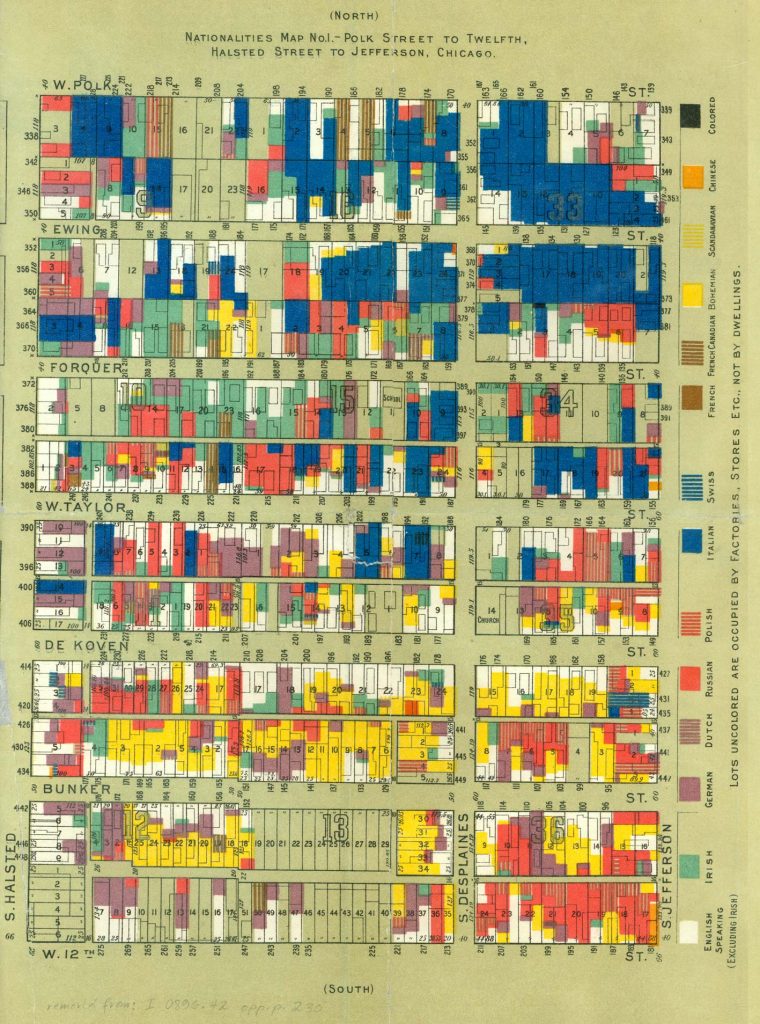

While looking at the second map, it’s important to point out that we would no longer use “nationality” to describe ethnic groups in the United States. “Ethnicity” would be a better label for this map. Also, instead of “Colored,” we would use Black or African American. You might also want to discuss with students the significance of not including African Americans and Irish Americans in the category “English speaking.” (Did the mapmakers use this term to refer to non-minorities, that is, white people who were born in the United States?)
When you show students this second map, ask them to come up with questions they might be able to answer using the information they can get from this map and the first map put together. Then ask them to give you questions they could still not answer about the neighborhood by looking at both maps.
What new questions can be answered with this map?
- How many different countries did the people who lived in this neighborhood come from?
- What countries did the largest number of people come from?
- Which groups have the smallest representation in the neighborhood?
- Which groups tend to have the highest incomes? (Find out by comparing the blocks of color on the two maps.)
- Which groups tend to have the lowest incomes?
- What conclusions can be drawn from the answers to these questions?
What questions cannot be answered with this second map?
- When was this map made?
- What do people do who live in this neighborhood?
- What was life like in this neighborhood?
- Did people in the neighborhood get along with each other?
- Why did people leave their countries and come to Chicago?
Background
Jane Addams and Ellen Gates Starr founded Hull House, Chicago’s first settlement house, in 1889. At one point, Hull House conducted a study of the people who lived in its Near West Side neighborhood. Many of them were recent immigrants, who came primarily from central, southern, and eastern Europe. These maps appeared in the volume Hull-House Maps and Papers, which was published in 1895.
For more background, read the entry “Hull House,” by Mary Ann Johnson in the Encyclopedia of Chicago.
Third Source – Autobiography Excerpt
From I Came a Stranger: The Story of a Hull House Girl
The excerpt provides information in a very different form from that of the maps. You may read it aloud or have students read it themselves. Or you might have students take turns reading it aloud to the class.
What questions could you answer using this excerpt?
- What were the buildings like in the neighborhood around Hull House?
- Where did kids play?
- What were the streets and sidewalks like?
- How did the people feel about their neighborhood?
- Where did people get their food?
- What kinds of stores were in the neighborhood?
- How was life for Hilda’s family different from life in your neighborhood today?
Ask students what questions are still left unanswered and where they might find more information to answer those questions.
Background
Hilda Satt Polacheck (1882-1967) came to Chicago from Poland with her family in 1892. The family settled in Chicago, in what was called the Near West Side neighborhood. Young Hilda became active at Hull House and wrote about the place and the neighborhood around it in her autobiography, which was published after her death.
Additional Resources
- More information about the Near West Side neighborhood of Chicago
- Information about and photographs of Hull House and the neighborhood
- Timeline of immigration into Chicago by decade from 1850 to 1990
- Greelety’s maps also appear in the collection essays “Immigration and Citizenship in the United States, 1865-1924” and “Chicago Workers during the Long Gilded Age”.
- Another excerpt from I Came a Stranger: The Story of a Hull House Girl appears in the collection essay “Faith in the City: Religion and Urban Life in Chicago, 1870-1920”.
There are many more books about Hull House in the Newberry Library General Collection on the 2nd floor of the library, including:
- The Many Faces of Hull House: The Photographs of Wallace Kirkland. Wallace Kirland and Mary Ann Johnson.
- Eleanor Smith’s Hull House Songs: The Music of Protest and Hope in Jane Addam’s Chicago. Graham Cassano, Rima Lunin Schultz, and Jessica Payette.
- Twenty Years at Hull-House, with Autobiographical Notes. Jane Addams.
Download copies of The Hull House Neighborhood lesson plan and sources below.



